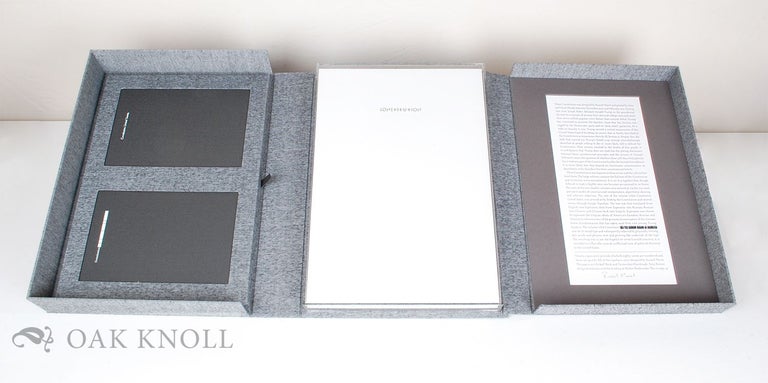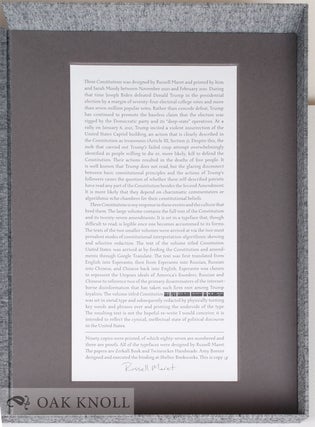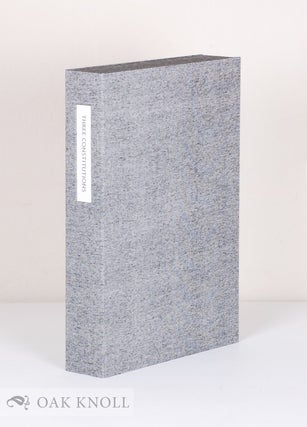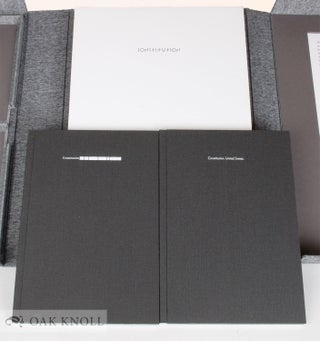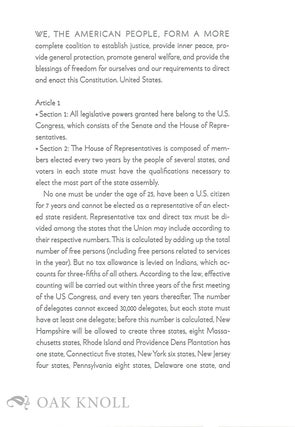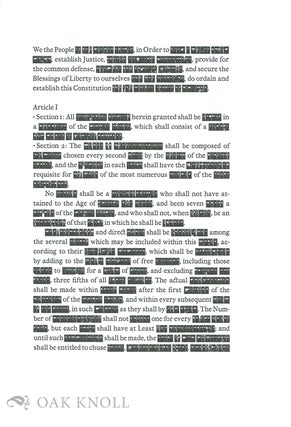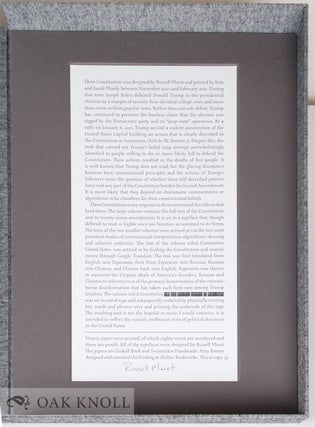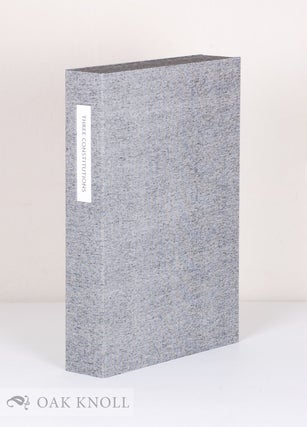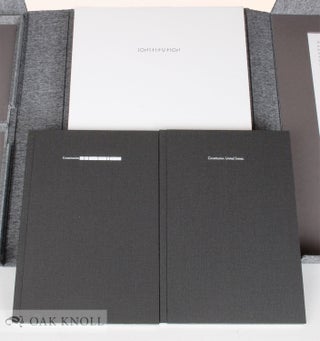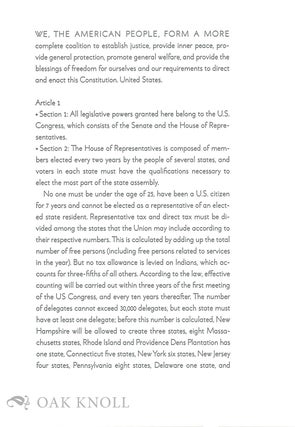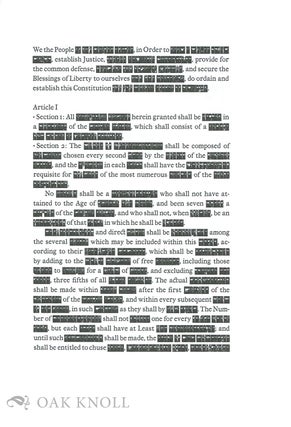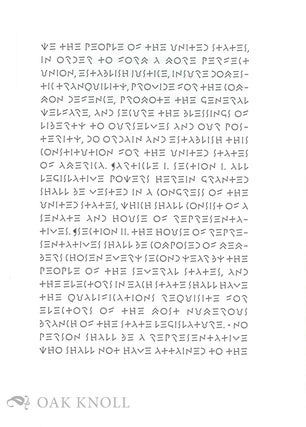THREE CONSTITUTIONS.
- New York, NY: Russell Maret, 2021.
- folio
- two volumes are bound in cloth covered boards, with the third volume bound in stiff paper with an exposed sewn spine. The clamshell houses the two similar volumes under a magnetic cover that holds the books in place while the third volume is housed under an acrylic see-through cover.
- unpaginated.
Price: $4,800.00 other currencies
Order Nr. 135963
Limited to 90 copies of which 87 copies are numbered. This copy is thus. Prospectus loosely inserted. All of the typefaces were designed by Russell Maret. The papers are Zerkall Book and Twinrocker Handmade. Amy Borezo designed and executed the binding at Shelter Bookworks. Three separate volumes housed in a three-tray drop-spine case measuring 11.25 x 15.75 x 2.625 inches.
Russell Maret, traditionally known for his many different typefaces and the beautifully produced books that are filled by them, has taken a different direction in Three Constitutions. Three Constitutions was created between November 2020 and February 2021, specifically around the 2020 United States presidential election. The surrounding events created much turmoil in the United States, so much so that Maret sought to collect his thoughts and create this book as his interpretation of the current political climate. The following is from the artist's website:
- Over the last five years, the content of my printing has steadily changed. Despite my past aversion to overtly political artists books, the social and political upheavals that have riven this country into splinters have slowly seeped into my work. The outrage that has been building inside of me for decades has attained a level of urgency that I can no longer ignore: from the criminal policies of Bushs war on terror, to Obamas enthusiastic embrace of drone assassinations, to the Republican Partys use of Congress as a means for minority rule. These things, and so many more, have gradually changed my understanding of what I want to make and why I want to make it. It is not a change that has been entirely welcome. So I have been exploring ways in which I can make politically inspired work that is both consistent with my aesthetics, and meaningful without being preachy or self-righteous.
While choosing the texts for my book Character Traits (2017-2019), I noticed that my choices were colored by the absurd grandiosity of our President and his enablers. The texts I chose referenced these influences in oblique, rather than blatant, terms. Some examples include the Libyan proverb, "My belly before my children," Conrads "Mr. Kurtz lacked restraint in the gratification of his various lusts...," Fernando Pessoas, "I have done more in dreams than Napoleon in life," and Melvilles, "There is no folly of the beasts of the earth which is not infinitely outdone by the madness of men." Though tentative and restrained, these textual choices were a first step into the political realm.
The timidity that I felt about bringing politics into my books was absent in my ephemeral work, and while I worked on Character Traits I began printing small mailings that allowed me to directly express my frustration, anger, and helplessness. These pieces ranged from works by Cicero, Aldus Manutius, and W. H. Auden, to simple, blunt statements such as TRAITOR and LOSER. The cards were distributed to friends, colleagues, and, the latter two, to the politicians who are actively working to undermine the principles of our Constitution.
Character Traits provoked another significant realization about how my lettering and type design relate to the content of my books. Throughout my career, my lettering has been divided into two distinct categories: large, interpretative letterforms on one hand, and proper, constrained typefaces on the other. For more than twenty years, I have tried unsuccessfully to find ways for these two alphabetical impulses to merge into some hybrid form. What Character Traits taught me was that it was not the lettering, but the content of my books, that was preventing me from doing this. The template I had been using in my work was to isolate my interpretative or abstract letterforms on single pages and then write notes about them in my more traditional typefaces. In order to merge my two lettering impulses, the content of my work had to change.
With all of these ideas swirling in the background, I began work on Three Constitutions. The book was inspired by the increasingly contentious conflict between "originalists," those who view the Constitution as a prescriptive cultural artifact delineating American civilization, and those who view the Constitution as a flexible instrument conceived to adapt to the evolving political, social, and racial realities of American nationhood. This is a conflict with which we are all familiar, but what got me started working on Three Constitutions was that, in the blaring echo chamber of the hourly news cycle, the originalists were, and are, dominating the discussion.
The problem with these zealous, self-described Constitutional "patriots" is not dissimilar from that of religious zealots: if (and its a big IF) they have bothered to read their primary document-the Constitution or whatever their holy book happens to be-they have done so through self-justifying blinders. How many originalists, for instance, concentrate on the fact that the fourth phrase of the Constitutions preamble is to "insure domestic Tranquility" or that the sixth is to "promote the general Welfare?" How many self-proclaimed Proud Boys understand that the second amendment is an amendment, and therefore provides its own justification for being revisited and amended further? How many red-hatted rioters understand that their actions directly contradict the Constitutions prescriptions for its own protection: that their actions are not patriotic but seditious.
During the three-month period in which Sarah Moody and I printed Three Constitutions (November 2020 to February 2021) there were many tragic examples of the conflicts described above. During that time, Joseph Biden defeated Donald Trump in the presidential election by a margin of seventy-four electoral college votes and more than seven million popular votes. Rather than concede defeat, Trump has continued to promote the baseless claim that the election was rigged by the Democratic party and its "deep-state" operatives. At a rally on January 6, 2021, Trump incited a violent insurrection of the United States Capitol building, an action that is clearly described in the Constitution as treasonous (Article III, Section 3). Despite this, the mob that carried out Trumps failed coup attempt overwhelmingly identified as people willing to die or, more likely, kill to defend the Constitution. Their actions resulted in the deaths of five people. It is well known that Trump does not read, but the glaring disconnect between basic constitutional principles and the actions of Trumps followers raises the question of whether these self-described patriots have read any part of the Constitution besides the Second Amendment. It is more likely that they depend on charismatic commentators or algorithmic echo chambers for their constitutional beliefs.
Three Constitutions is my response to these events and the culture that bred them. It consists of three volumes. The largest contains the full text of the Constitution and its twenty-seven amendments. It is set in a typeface that, though difficult to read, is legible once one becomes accustomed to its forms. It is housed in a vitrine as if it were an immutable relic rather than a living, adaptable document. The texts of the two smaller volumes were arrived at via the most prevalent modes of constitutional interpretation: selective redaction and algorithmic skewing. The volume titled Constitution is set in my metal typeface, Hungry Dutch, and subsequently redacted by physically turning key words and phrases over and printing the underside of the type. The resulting text is not the hopeful re-write I might propose; it is intended to reflect the cynical, ineffectual state of political discourse in the United States. The text of the volume titled Constitution. United States. was arrived at by feeding the Constitution and amendments through Google Translate. The text was first translated from English into Esperanto, then from Esperanto into Russian, Russian into Chinese, and Chinese back into English. Esperanto was chosen to represent the Utopian ideals of Americas founders; Russian and Chinese to reference two of the primary disseminators of the internet-borne disinformation that has taken such firm root among Trump loyalists.
When taken as a whole, the books in Three Constitutions are intended to embody the fractured state of political discourse in America.

